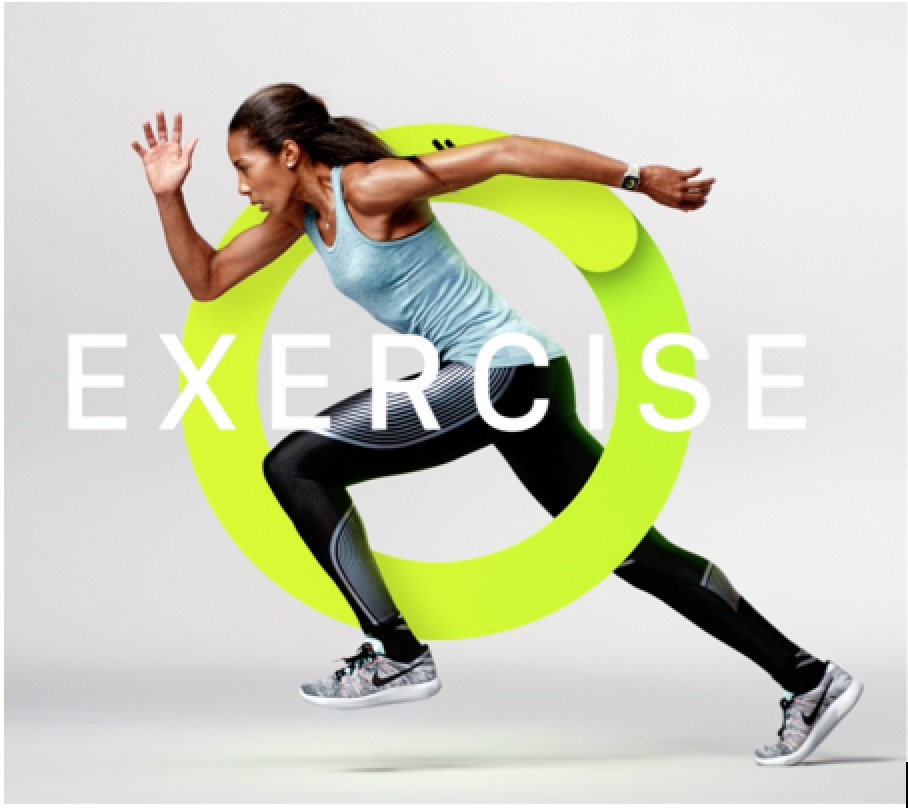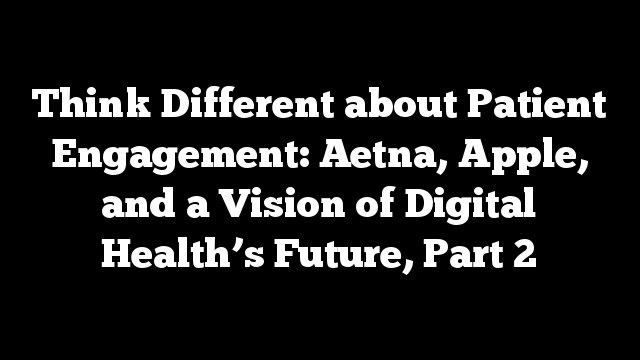
This is the second post in a series on digital health inspired by Aetna and Apple, whose developing partnership is poised to impact millions of Americans. Part 1 is Mystery Mission in LA.
Getting to Patient Engagement
“Patient engagement” is a popular phrase in healthcare these days, but how do you actually get people to take a greater role vis a vis their own health and healthcare? As the first Director of Consumer eHealth at ONC in the US federal government, I spent several years making the case for strengthening patient engagement with technology, and trying to figure out how to make it happen at scale. With Aetna and Apple working together, I think we’re a step closer.
Using the $36 billion+ federal “meaningful use” program–which catalyzed doctors’ migration from paper files to EHRs—as a hook, we required hospitals and doctors to give patients the capability to access (and use or share) their own health records online. The proportion of healthcare providers who give patients electronic access to their medical records has skyrocketed along with EHR adoption. As of 2015 (the most recent data available from ONC), nearly 70% of US non-federal acute care hospitals enabled patients to view, download, and transmit their health records electronically—up from just 10% in 2013. That’s a huge step in the right direction, but we’re still far from achieving the vision I share with an impassioned community of changemakers: a world in which patients live healthier, fuller lives that revolve around meeting their own personal priorities—supported by doctors/nurses, family members, communities, and digital data and tools.
At ONC, we summed up the systemic changes needed to achieve this vision with “the three A’s”:
- Access—Digital access for patients to information about health, including their own medical records
- Action—Digital tools including apps and wearables that help patients to take concrete action, informed by data from their medical records and other sources
- Attitudes—A culture shift from a relatively paternalistic model of healthcare that focuses on “sick care” to one in which patients and families are at the center of their own health and care, and are recognized as taking the lead in daily activities that impact their health, whether through prevention or management.
The partnership between Aetna and Apple could push us significantly toward achieving all three As. In the Access bucket, through health insurance claims, Aetna likely holds the data needed to compile a unified, comprehensive health record for an individual patient from multiple providers. And if Aetna expands use of the Apple watch to all of its 23 million members, that’s a significant swath of the population. In the Action bucket, the Apple watch has its own clean interface and reminders to encourage healthy behaviors, and links to a wide variety of compelling specialized third party apps, devices, and tools. Finally, the importance of the final A–changing Attitudes, is often underestimated, but it’s here that Apple’s unique brand appeal could turn the tides in how we think about health and healthcare.
My medical records are irrelevant. Or scary. Or boring!
The public is still learning about the online availability of their medical records, though more than a third who have such access still aren’t aware, according to a 2016 survey from Accenture, which also found that people ages 65 to 74 are the most likely to access their EHR data to manage their health, while people 18 to 34 are the least likely. Not surprisingly these “young invincibles” are also among the least likely to buy health insurance under the Affordable Care Act.
Whether young or old, for many of us, not thinking about health at all is the ideal—it means there is nothing wrong—no immediate threat to the body or the wallet. On a deeper level, though, perhaps we fear that poking around in our health records might reveal that we’re not as healthy as we thought. Or even remind us that we’re mortal, a reality most Americans are skilled at avoiding.
And why would anyone choose to engage with the healthcare system unless they absolutely had to? It’s chock full of bad associations beyond illness and mortality—including huge and unpredictable bills and poor customer service. Besides, most people believe their doctor has everything under control… right?
Enter the Most Powerful Brand on Earth
Have a look at the latest ads for the Apple’s watch ? Beautiful, athletic people in cinematic surroundings. These images couldn’t be farther from a dull or preachy public-health PSA or pamphlet urging you to get more aerobic exercise or eat more fiber. Apple has topped the list of the most powerful brands in the world for seven years straight. It represents innovation, creativity, and good design. Think different.
What if Apple, with its brand appeal bolstered by marketing dollars, can help us “think different” about health and healthcare? If Apple can lend its luster to the mundane yet often difficult tasks on which health depends—eating well, moving enough, sleeping well, managing stress—that’s a big win, especially if it can also deliver just-in-time nudges and other tools to help us take the small steps that add up to big change . In partnership with Aetna and its data and scale, Apple may be able to help shift our overall culture to prioritize wellness and prevention.
Yeah, but wellness isn’t equivalent to health. What about people who are seriously ill?
Some argue that the Apple watch is impacting only the most peripheral of health topics—wellness, and that walking a few more steps doesn’t help with cancer or diabetes. Actually, though, I think it does. For one thing, prevention and management of most chronic conditions requires attention to the universally beneficial tasks of healthy living, often while juggling additional tasks including taking medications. For another, the Apple watch already goes beyond wellness, serving as a platform to connect devices such as glucose monitors to address specific health condition needs—and I imagine this trend will continue, particularly if the wearer can give it health record details via Aetna. The watch has already saved lives by detecting early signs of heart trouble.
Yeah, but Apple is only for the rich. What about everyone else?
It’s critical that everyone—especially the poorest and sickest people—benefit from health technologies that can boost health and healthcare. As I see it though, the fact that an Apple watch, which retails at about $350 for the latest model, is too expensive for many people isn’t in itself a problem. For one thing, Apple is a private company, not the government. There is nothing illegal or inherently immoral in creating a luxury product. In the bigger picture it is up to policy makers to figure out how to leverage such tools for everyone, but it’s not Apple’s responsibility. In addition, through their partnership, Aetna may help to bring Apple watches to an economically diverse audience by subsidizing or covering their cost entirely.
In the longer term, though, I think other tech companies will follow Apple’s lead in health to provide lower-cost options to for different demographic groups. The design features of today’s Louis Vuitton purse are clearly recognizable in next season’s knockoff, available in the streets of New York and Hong Kong for a fraction of the price. When the iPhone was introduced in 2017, only 6% of the population had smartphones; today, more than 80% of Americans do—and they’re not all provided by Apple.
Author’s statement of conflict of interest: I am not employed by Aetna or Apple. While my participation in the event described was paid for by Aetna, I was not required or asked to write about the experience.
